Do not be misled by their name, praying mantises are not always praying, sometimes they eat too. Praying mantises have a diet that is unlike most stick insects’. Most stick insects are herbivorous. So, they eat plants.
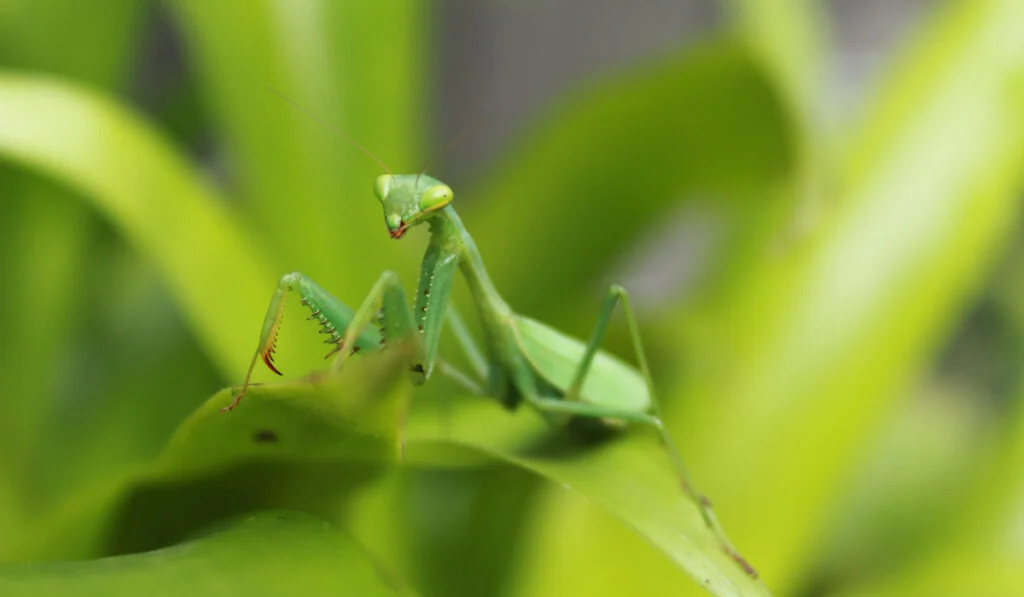
But with praying mantises, it’s a different story. Praying mantises are carnivorous, they eat insects, flies, birds, and even some reptiles.
This article focuses on all you need to know about what praying mantises eat, the things they don’t eat, the frequency of their meals, and many more.
Table of Contents
The Praying Mantis Diet
You would most likely find praying mantises feeding on live animals. The structure of their body facilitates their hunting.
For one, their skin color is usually green or brown, and this blends with leaves, allowing them to go unnoticed until they catch their prey.
Then there’s the neck that rotates 180 degrees. Their neck allows them to have a broad range of surveillance without moving their body. So, they can find their prey while staying still.
They attack and grab their prey with their forelegs. The forelegs have long spines, which are used to stab and kill their prey.
There’s a significant list of animals praying mantises prey on, and we shall be discussing a few of them.

Praying Mantises
Well, this is a bit of an irony. Praying mantises may have a long list of insects they can eat. But they belong on that list too.
Praying mantis are not totally safe from other praying mantis because they can feed on each other.
Cannibalism among mantises usually occurs after mating. The female praying mantises kill and eat the male praying mantises. But the chances of this happening are low.
Another case of cannibalism is seen with newly-hatched praying mantises. If you have so many newly-hatched mantises in the same place, chances are they will start eating each other sooner than later.
In extreme cases, praying mantises will also feed on each other when there’s no other animal to prey on.
Ants
Praying mantises will eat ants though babies are more likely to do so than adults. The small size of an ant makes it perfect prey for newly hatched praying mantis nymphs.
A fully-grown ant usually has a size that falls between 6 and 12 mm. In fact, the largest species of ant grow to be around 2 inches.
On the other hand, the average fully-grown praying mantis has a size between 4 – 6 inches.
This means the average adult mantis is 15 – 30 times bigger than the average adult ant, and 2 – 3 times bigger than the largest species of ants.
So, when it comes to size, ants stand no chance against mantises. Apart from their size, mantises are masters of stealth. Many times, they just sit still and wait for when the ants are within their grasp. Then they strike and feed.
Hummingbirds
A pray mantis’ appetite is not limited to insects. You just might catch a mantis eating small birds like hummingbirds. Usually, the birds they prey on are approximately the same size as them or smaller.
One study showed that praying mantises killed and ate many different kinds of birds. Hummingbirds accounted for 1/3 of the 24 total bird species that fell victim to this insect.
It is unlikely for you to find a mantis eating a bird significantly larger than it. So far, besides hummingbirds, mantises also eat finches, sparrows, canaries, and warblers.
In their usual hunting style, they lay still around bird feeders, waiting for the right moment to attack. Then they strike and grab the hummingbird very fast. They start by eating through the bird’s skull or chest.
Lizard
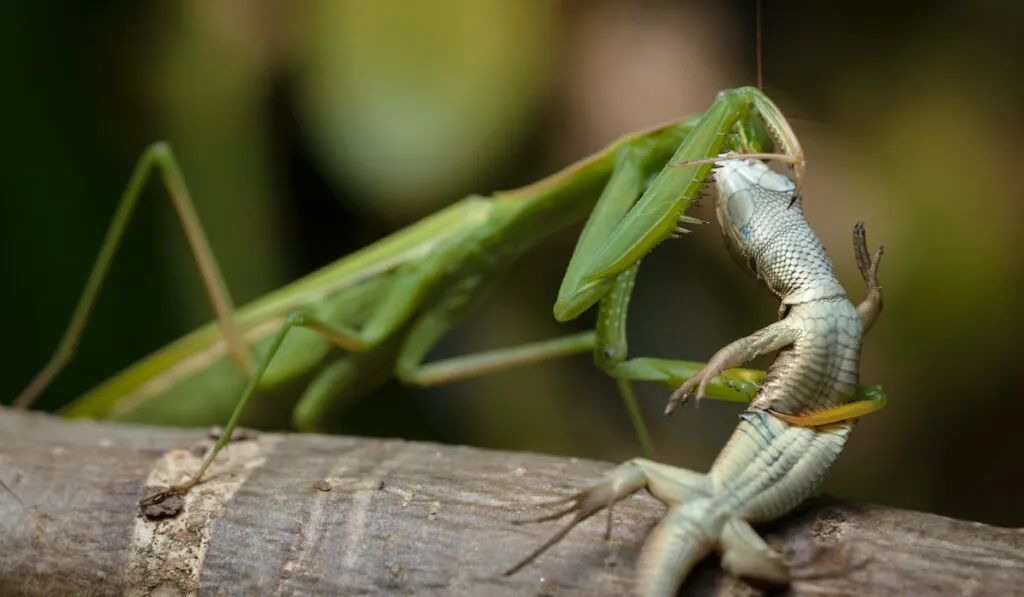
We all know that lizards are predators to insects. So, it may never cross your mind that lizards can be eaten by an insect – the praying mantis. Of course, once again, this depends on the size of the lizard.
Komodo dragons are lizards too, and they grow as large as 12 feet, which is about 20 times the size of an adult mantis. You shouldn’t expect a praying mantis to go after a komodo dragon, that’s just suicide.
You are more likely to see a praying mantis eating smaller lizards like geckos.
Bees
Praying mantises also prey on bees. In this case, size also plays a part in the feeding habit. Studies show that bees and wasps tend to avoid bigger mantises than smaller mantises.

Unlike other insects, the praying mantis’ predation of bees has effects that extend beyond bees. The presence of big praying mantis prevents bees from having their recruitment dance.
The absence of their recruitment dance can lead to a decrease in pollination. A fall in pollination may affect plant growth.
Wasps
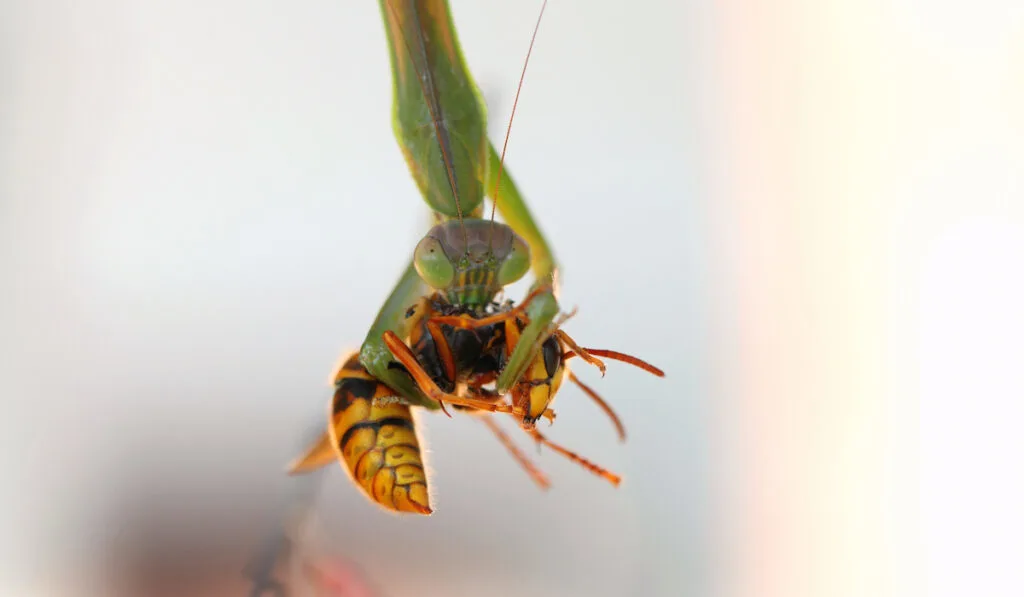
The relationship between wasps and praying mantises is a bit poetic. Like mantises, wasps eat smaller bugs. But they get eaten by bigger bugs – praying mantises.
Though wasps have hurtful stings that can harm the mantises, it doesn’t always happen this way. Many times, when the mantis grabs a wasp, the wasp becomes restrained in a way that it can’t sting.
Butterflies
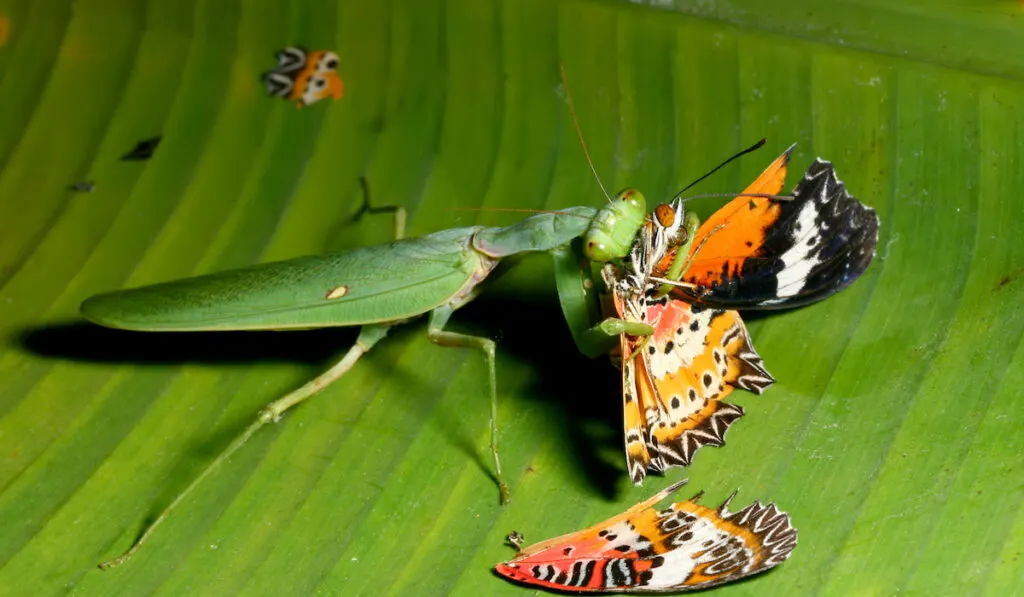
At this point, it will come as no surprise to hear mantises also eat butterflies. They do not limit themselves to adult butterflies since they also eat caterpillars.
Although some butterflies, like the monarch butterfly, are poisonous, praying mantises are unaffected by their poison. Studies show that the Chinese mantis removes the guts of monarch butterflies and caterpillars before eating them.
Also, some of the poisons in these preys are not absorbed in the gut of praying mantis. Hence, their harmlessness.
Beetles
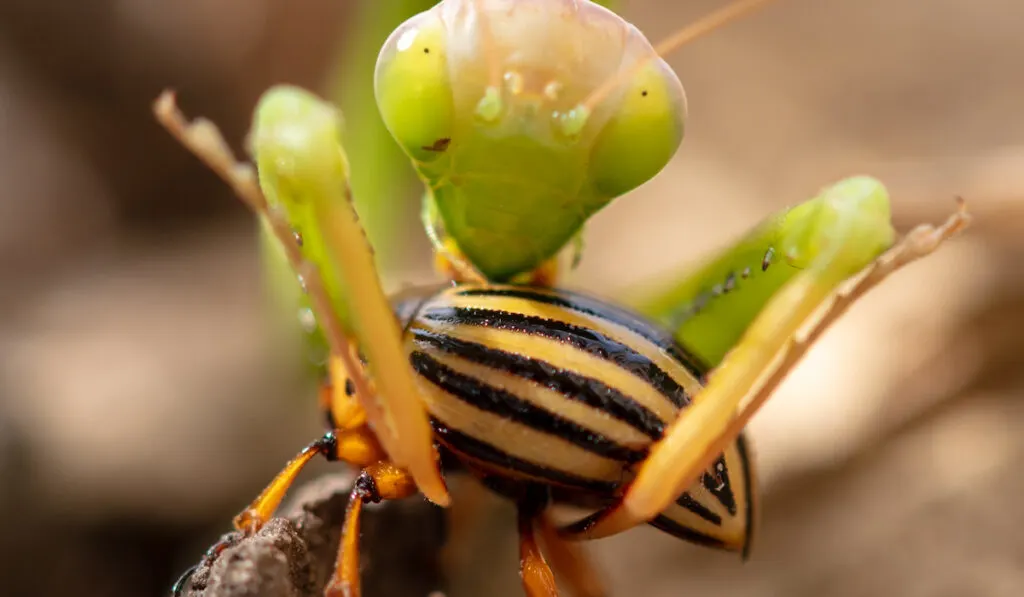
When younger, praying mantises may not eat beetles. In infancy, they prefer prey with soft bodies. But when they get older, beetles become a part of their diet.
Spiders

There is a peculiar relationship between spiders and praying mantises. Spiders can eat praying mantises; praying mantises can eat spiders.
Whether the mantis or spider gets to be the prey or predator depends on their sizes. In any instance, the larger animal will be the predator, while the smaller animal will be the prey.
Also, the animal that attacks first will most likely be the predator. So, if a mantis gets caught in the web of a spider, it is as good as spider dinner.
Apart from the animals discussed above, the following are some other bugs and animals that fall prey to praying mantises:
- Worms
- Locusts
- Crickets
- Potato Bugs
- Sow Bugs (Roly Polys)
- Ticks
- Cockroaches
- Ladybugs
- Mosquitos
- Black Widows
What Praying Mantis Do Not Eat
You will not find praying mantises eating dead prey. They hunt, kill, and eat their prey. So, if you are keeping a praying mantis, you have to feed it with live insects.
Mantises cannot eat animals significantly bigger than them. As we said earlier, that’s just suicide.
Remember we said praying mantises are carnivores? Well, unlike many of the tiny animals in your garden, your plants are safe from direct harm by mantises. But this does not rule out the possibility of mantises eating plants.
Some studies show that Chinese Mantis, a specie of praying mantises, sometimes feed on pollen. But if they can find their usual prey, they will not consider eating pollen.
How Long Can Praying Mantis Go Without Food
Praying mantises do not have to eat every day. They typically eat every 2 – 3 days and can go up to 2 weeks without food.
Some extreme species can even go up to a month without food. Mantises also drink very little water. So, if you are keeping a pet mantis, the chances of you leaving them to starve are very low.
Resources
- https://academic.oup.com/ee/article/32/4/881/358658
- https://usmantis.com/pages/mantis-faq
- https://praying-mantis.org/do-praying-mantis-eat-ants
- https://roaring.earth/praying-mantises-are-attacking-birds-and-eating-their-brains
- https://www.livescience.com/59700-praying-mantises-eat-birds.html
- https://roaring.earth/mantis-eats-lizard-alive/
- https://www.quora.com/Do-giant-mantises-eat-lizards
- https://www.ncbi.nlm.nih.gov/pmc/articles/PMC3903792/
- https://www.researchgate.net/publication/314857085_Feeding_on_toxic_prey_The_praying_mantis_Mantodea_as_predator_of_poisonous_butterfly_and_moth_Lepidoptera_caterpillars
- https://animals.mom.me/natural-predators-wasps-7754.html
- https://animalstime.com/what-praying-mantis-eat
- https://homeguides.sfgate.com/benefit-releasing-praying-mantis-garden-77588.html
- https://plantcaretoday.com/praying-mantis.html
- http://www.bioone.org/doi/10.1676/16-100.1

